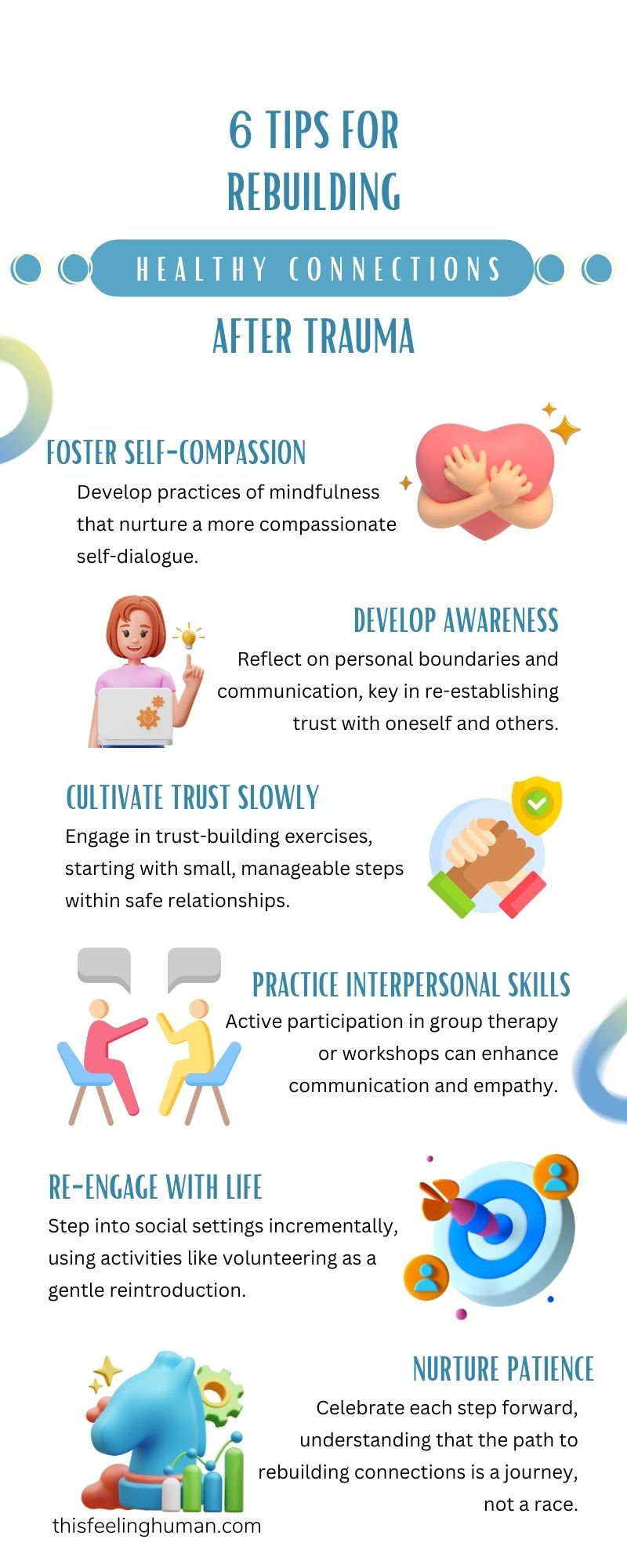Trauma's Impact on Connections and the Motivating Force of Emotions in Action
- TFH

- May 10, 2024
- 5 min read
Updated: Aug 8, 2024
Trauma, by its very nature, is an invasive disruptor of life's narrative, leaving in its wake a complex web of emotional, psychological, and relational challenges. The disruption of connections that trauma precipitates is not solely a phenomenon of the external world—the relationships we have with others—but also deeply affects the internal world and the relationship we have with ourselves. This dual disruption underscores the insidious capacity of trauma to alter one’s sense of security, identity, and belonging.
Internal Rift
On an intrapersonal level, trauma can fracture a person's self-concept, leading to a profound sense of disconnection from oneself. Survivors often report feeling estranged from parts of themselves, grappling with feelings of shame, guilt, and unworthiness. This internal rift complicates the process of forming secure attachments because it hinders the essential foundation of trust: trust in oneself. The erosion of self-trust manifests not only in doubts about one's judgment but also in hesitancy to listen to and care for one’s own needs and boundaries.
The External Barrier
Understanding the aftershocks of trauma helps us navigate the complexities of interpersonal relationships. This insight is often missing in our approach to managing emotional experiences, both comfortable and uncomfortable.
Every feeling has an important story to tell. In my free ebook titled My Guest House, written four years ago, I explored how emotions have a purpose and open doors to our deep-seated thoughts and beliefs.

To help readers understand their trauma better, we partnered with The School of Emotions to promote Emoli Cards for emotional literacy. Each feeling has a story, an impulse, and a purpose.
Trauma's story is one of fear and protection. Feeling anxious or distrustful points to a thought and belief that something is dangerous or threatening and needs to be guarded against. Hence, the impulse is to erect walls and avoid vulnerability, which stifles the growth of trust and intimacy. We stop then to consider our actions, sometimes leading us to self-blame for the inability to connect or for overreacting.
How often do we sit with discomfort without judgment and with curiosity?
This is why we set out to provide Emotion-Based Coaching. Using a combination of Emoli Cards, which tell us the story of our emotions, Calm3D, an immersive mood regulation tool, and a life coaching session, we help our clients understand what their trauma is telling them and how they should respect the part in them that is acting out. This references the parts in us that may hold a collection of memories, even traumatic ones, and act out sequences of actions and reactions based on beliefs that serve to keep us safe—concepts explored in Internal Family Systems and Somatic IFS.
Navigating the Path to Connection
Reconnecting in the aftermath of trauma is both a journey inward and outward. It entails a reacquaintance with the self—recognizing and honoring the body and mind’s response to trauma as protective, not pathological. It involves cultivating self-compassion and acknowledging the immense courage it takes to face the vulnerabilities and pains that trauma has brought.
Equally, it involves a cautious yet hopeful exploration of the external world of relationships. Building or rebuilding secure attachments requires the presence of emotionally responsive and consistent others. These are individuals who recognize the value of patience and the non-linear nature of healing. They offer a relational space where trust can be incrementally built, where fears can be expressed and met with understanding rather than judgment.
Tips for Rebuilding Healthy Connections After Trauma:

1. Foster Self-Compassion:
Develop practices of mindfulness that nurture a more compassionate self-dialogue.
2. Develop Awareness:
Reflecting personal boundaries and communication is key in re-establishing trust with oneself and others.
3. Cultivate Trust Slowly:
Engage in trust-building exercises, starting with small, manageable steps within safe relationships.
4. Practice Interpersonal Skills:
Active participation in group therapy or workshops can enhance communication and empathy.
5. Re-engage with Life:
Step into social settings incrementally, using activities like volunteering as a gentle reintroduction.
6. Nurture Patience:
Celebrate each step forward, understanding that rebuilding connections is a journey, not a race.
Ultimately, healing from trauma and reconstructing the capacity for healthy connections involve an earnest confrontation with vulnerability. It is through sharing our stories, expressing our fears, and accepting care that we find our way back to deeper connections, both with others and with ourselves.
How Our Emotions Drive Purposeful Action
In the subtle, often overlooked inner-work of our day-to-day lives, emotions surge as powerful undercurrents shaping our decisions, actions, and interactions. Rarely do we pause to consider these forces as anything more than fleeting states or reactions to external stimuli. Yet, what if we were to reframe our perceptions of these emotional movements—not merely as disturbances to be managed but as potential catalysts propelling us towards greater personal fulfillment and purpose? This shift invites us to not only acknowledge but actively organize our emotional landscapes to enrich our lives.
Understanding the Motion of Emotions
Emotions, from the gentlest of happiness to the fierceness of anger, are inherently dynamic. They compel us to move, to change, and to react. At their core, emotions are data, informing us about our environment and our values. When fear arises, it signals potential threats and prepares us for action. Joy indicates alignment with our desires and interests, beckoning us toward what we love. Each emotional state prepares the body for a set of actions — run, fight, embrace, withdraw.
By viewing emotions as messengers, we can start to appreciate their potential to guide us toward a life more aligned with our ideals and aspirations. Instead of suppressing or ignoring these signals, organizing and understanding them can be the first step toward harnessing their potential.

Emotions as Problems vs. Emotions as Assets
Traditionally, intense emotions are viewed as problems to be solved. Society often teaches that control over one's emotional world is a sign of strength. However, when we categorize only certain emotional responses as acceptable, we lose out on the rich tapestry of feedback our emotions provide.
Instead, consider emotions as assets. Each feeling offers insight into our deepest values and fears. By organizing our emotional responses and understanding their origins, we might enhance our decision-making processes, improve our relationships, and navigate life with more deliberate intention.
Organizing Emotional Assets for Actionable Insights
How do we begin to organize our emotions constructively? It starts with observation. Track your emotional responses without judgment. Use journaling or mood-tracking apps to note what triggers various emotions and how you respond. Mapping out these patterns is akin to a scientist gathering data.
With consistent observation, patterns will emerge. You may discover that certain environments consistently trigger stress, or particular projects ignite passion and joy. This knowledge is powerful. It allows you to make informed decisions about where to invest your energy.
Next, channel these insights into purposeful actions:
Prioritize Environments That Foster Positive Emotions: If creativity sparks joy, structure your day to include creative pursuits, even if only in small increments.
Create Boundaries Around Negative Emotional Triggers: Understanding what causes stress or sadness can help you avoid these triggers or develop coping strategies.
Use Emotions to Guide Your Career and Relationships: Align your professional and personal life with values and passions reflected in your emotional responses. This alignment often leads to more profound satisfaction and success.
Emotions in Leadership and Community
In a leadership role, your ability to organize and utilize emotions can inspire and motivate others. Emotionally aware leaders can foster environments where team members feel valued and understood, leading to higher productivity and satisfaction.
In communities, shared emotional responses can unify people, spurring collective action towards common goals. Recognizing and organizing these emotional assets on a community level can drive significant social and political change.
Conclusion: Moving Forward with Emotional Acumen
Emotions are not merely internal experiences but are profound sources of energy that can propel us forward in life. By viewing them as valuable assets and organizing them effectively, we can enhance our sense of purpose and engage more meaningfully with the world around us. Let's acknowledge the power of our emotions, not only to feel, but also to act — and let these inner movements guide us towards a purposeful and fulfilling life.

Comments